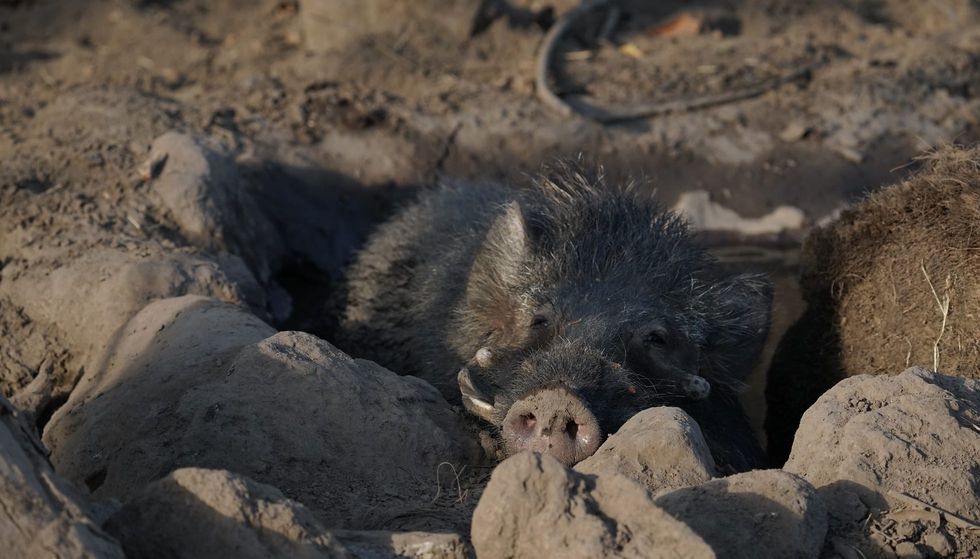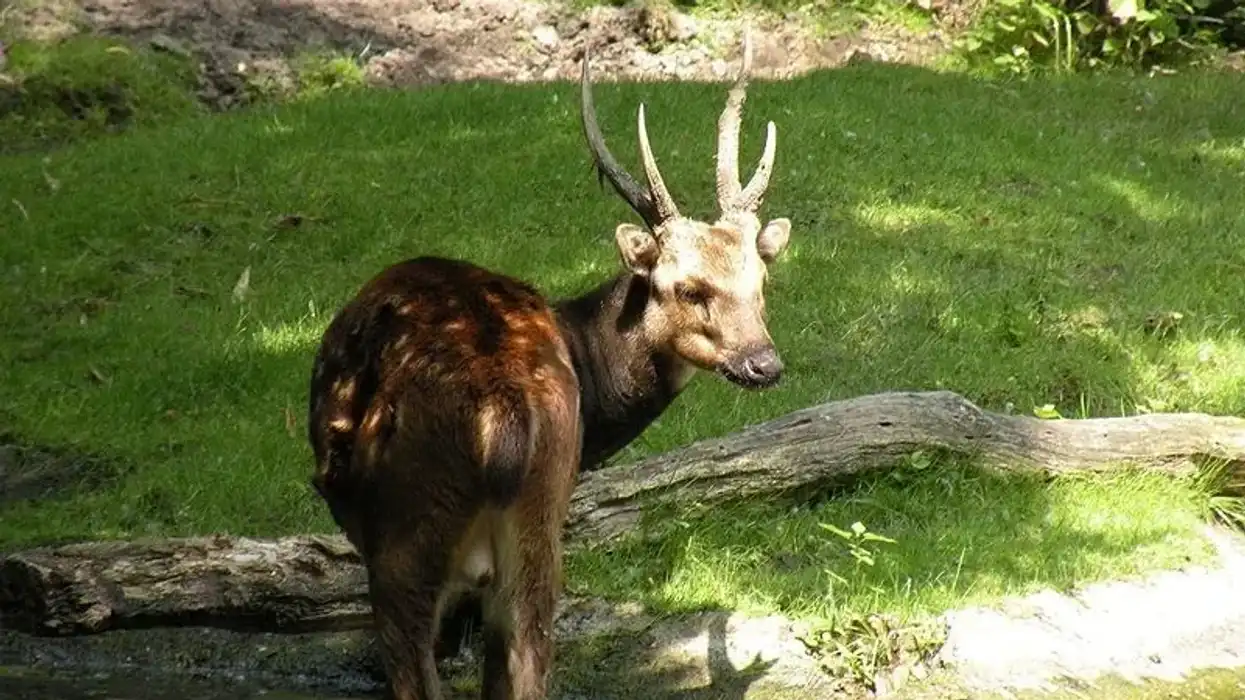If you enjoy learning about animals who live on a farm, then you might feel right at home reading about a pig.
But be careful, the Javan pig is like no other domesticated pet, and can be quite vicious when it wants to be! This is why, if you ever do run into one on the islands of Java, the best thing to do would be to give them the wide berth and admire them afar!
These large, brown-colored pigs are well known in the Javan Islands near Indonesia, and are not only speedy runners, but also excellent swimmers!
They usually live in the savannas of East Asia, focused around the Javan Islands, and are usually found living very close to the sea level in places as low as 2625 ft (800 m). They are not really sociable animals and will be frequently seen wandering around their habitats alone.
They can, however, be seen in great numbers around the breeding season, which is mostly during the rainy season.
If you want to learn more about these unique animals, then read on, and if you would like to know more about other animals, then check out these facts on the Tolai hare and the European mole.
Javan Warty Pig Interesting Facts
What type of animal is a Javan warty pig?
Warty pig (Sus verrucosus) is a type of pig.
What class of animal does a Javan warty pig belong to?
Warty pig (Sus verrucosus) belongs to the class Mammalia.
How many Javan warty pigs are there in the world?
According to a recent study, the Javan warty pig's population size is 172-377 individuals, putting it among the rarest pig species. However, just because the Javan pig is so sparsely populated, does not mean all species of the pig are suffering!
The population of domestic pigs is about 2 billion in the world – which makes them some of the most common pig species in the world.
Where does a Javan warty pig live?
Javan pig species live in savannas. These pig's home is Java Island. These animal species have a habitat in the secondary forests in the area. Javan warty pig's scientific name is Sus verrucosus.
What is a Javan warty pig's habitat?
This species is endemic to the islands of Java. Javan warty pig habitat is grasslands and secondary forest at altitudes below 2625 ft (800 m). They are found living in grasslands with a relatively less supply of freshwater, tall grass, and plentiful vegetation.
Who do Javan warty pigs live with?
Warty pig (Sus verrucosus) are mostly crepuscular or nocturnal animals. These animals really aren't particularly sociable. Adult females and their newborn kids may be observed together, while adult males – except while breeding – stay alone in wild.
How long does a Javan warty pig live?
The lifespan of a warty pig (Sus verrucosus) indigenous to the Java island, is 8 years on average, with very few individuals in captivity living to be fourteen. Pigs, in general, survive for an average of 15 to 20 years.
How do they reproduce?
The Javan warty pig's breeding season range is considered to extend from September to December. The gestation period of this animal is about four months.
Once a year – mostly during the rainy season (January to March) – the mother gives birth to is three to nine piglets in a nest and they stay there for a while. Weaning happens around the age of three to four months of this pig.
Another animal which belongs to the same family of Javan pig is the banded pig. The piglets of this animal are produced in litter sizes of two to six, in the months of December to March and are nurtured in grassy nests built by the mother.
What is their conservation status?
According to the IUCN Red List, these Javan warty pigs endemic to islands of Java, are listed as Endangered species. This is because not only is their population concentrated in certain locations in the Javan islands, they are also losing their habitat due to pollution, poaching, and other issues of conservation.
There are several NGOs at work to protect them, and with any luck, we can expect to see a sharp incline in their population.
Javan Warty Pig Fun Facts
What do Javan warty pigs look like?

*Please note that this is an image of a banded pig, not a Javan warty pig. If you have an image of a Javan warty pig, please let us know at hello@kidadl.com.
A long-haired mane slides alongside the back of the neck, along its spine, and then all the way to the rear on every individual of this species. As the hairy mane spreads backward, it becomes thinner. The hairs of this species are normally reddish in color, with a sharply defined underside as the hair goes yellowish in color.
These Javan pigs have long tails and slender legs. A tiny tuft of hair can be found on the tail.
When viewed in profile, the head is massive, hefty, and slightly convex. The ears are huge and the face is lengthy. Male Javan pigs are substantially bigger than females.
The preorbital warts are a pair, while the infraorbital and bigger mandibular lesions are the other two.
How do they communicate?
With the help of a shrill whistle, this animal, native to the Java island, can alert one another of peril in wild. This shrill whistle is used to signal an emergency. These creatures are likely to communicate via a range of visual signals, as well as, tactile communications – particularly between couples and mothers, and offspring.
How big is a Javan warty pig?
The average length range of the Javan pig species (Sus verrucosus) is around 35-75 in (90-190 cm). Though Juliana pig's length range is about 12-26 in (30-66 cm). Javan pig species is much larger than the Juliana pig species.
How fast can a Javan warty pig move?
Javan pig species, listed as Endangered by the IUCN Red List and there is not enough data of speed although it is a speedy runner and swims easily. It is easy to see that the Javan islands are a difficult terrain to be in, which not only makes their legs stronger but also more durable.
This gives scientists reasonable cause to expect that the Javan pig is a fast runner.
How much does a Javan warty pig weigh?
Javan pig (Sus verrucosus) males grow to an average of 238 lb (108 kg), while females are around 97 lb (44 kg).
What are the male and female names of the species?
There are no sex-specific names for Javan pigs.
What would you call a baby Javan warty pig?
There are no specific names for baby Javan pigs, but generally babies of pigs are called 'piglets'. They are known to be relatively cute as opposed to adults.
What do they eat?
As Javan pig species (Sus verrucosus) have their habitat in secondary forests, they are omnivores and eat everything. Vegetables, wild organisms, and human crops are known to be eaten by them. Their diet includes seeds, tubers, roots, bark, and grains in the wild.
Are they dangerous?
Javan pig (Sus verrucosus) species, native to Java Island, is not dangerous for humans. However, they do possess an aggressive streak when attacked or if someone comes too close. This becomes especially true during the breeding season, which is why it is best to admire them from far.
Would they make a good pet?
These Javan pig species (Sus verrucosus ) have the potential to be smart and loving animals. However, they are not suitable pets for everybody.
A pig may undoubtedly be an asset to a family if given the correct attention and training. These pig species are intelligent and inquisitive, making it tough to keep them engaged.
However, before you choose to adopt a Javan pig, it is important to be aware of local regulations around conservation. Since they are endangered animals, local laws might prohibit people from adopting the Javan pig as a pet.
Did you know...
If you are looking for a pet other than the Javan pig to adopt, then the Guinea pigs are wonderful pets. They live over many years, allowing you to enjoy them for a longer period of time than any other rodent.
They have individual characteristics and are extremely loud, making it simple to recognize and bond with them. They are a joy to play with and keep you entertained.
The Eurasian wild pigs (Sus scrofa) also is widespread throughout Java, and several early records mix up these two species. Female and male Eurasian wild pigs are 'nearly indistinguishable' in the environment from juvenile and female Javan pigs, however, male Javan pigs can easily be distinguished from these wild pigs by their much bigger size and distinctive warts.
The banded pig or Indonesian wild boar (Sus scrofa vittatus) is indeed a species of wild boar that is widespread to the Thai-Malay Peninsula and numerous Indonesian islands, including Java, the Lesser Sundas, and Sumatra.
Why is the Javan warty pig Endangered?
Javan pig species (Sus verrucosus) are indigenous animals to the island of Java and have an extremely small population. They, like many other pig species in the region, are threatened (listed as Endangered by the IUCN Red List) with dwindling habitat owing to human influence.
Agriculture had a significant impact on the extinction of the Javan warty pigs. The meat of this wild pig is hunted.
Growers who see the pigs plundering their fields late at night also shoot these animals. Because these are such huge animals, sports hunters regard killing them as a challenge and a reward.
The World Association of Zoos and Aquariums' latest conservation action plan intends to capture healthy and fit Javan pigs and reproduce them in confinement. After that, the program's piglets are meant to be transferred to protected areas.
How many Visayan warty pigs are left?
Only around 300 Visayan warty pigs (Sus cebifrons) live in captivity, and its number in the wild is unclear. The great news would be that the Visayan mates well enough in captivity, hence, the animals are being raised in zoos and some other institutions across the world in the hopes of restoring them to the wild.
Conservation efforts continue to be underway, and with enough time, we hope to see them climb the ranks of the IUCN Red List to become a species of Least Concern.
Here at Kidadl, we have carefully created lots of interesting family-friendly animal facts for everyone to discover! Learn more about some other mammals from our wildebeest facts and highland cattle facts pages.
You can even occupy yourself at home by coloring in one of our free printable Javan warty pig coloring pages.










